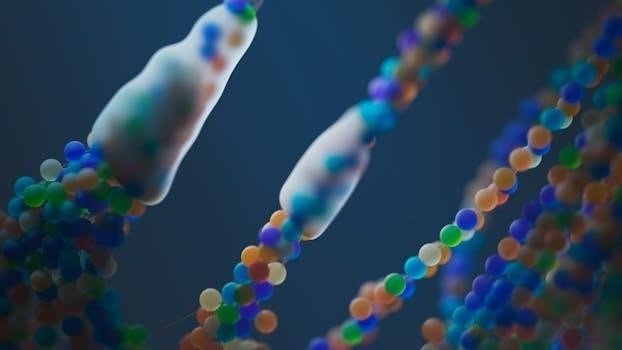Life⁚ The Science of Biology PDF ― Overview
Life⁚ The Science of Biology is a comprehensive text exploring biology’s fundamental principles. It covers diverse topics, emphasizing experimentation, critical thinking, and skill mastery, particularly in the twelfth edition and its digital updates.
Definition of Biology
Biology, derived from the Greek words “bios” (life) and “logos” (knowledge), is fundamentally the science of life. It encompasses the study of living organisms, their origins, history, structures, functions, and interactions. Biologists explore life’s processes, seeking explanations through scientific methods. This includes making discoveries, observing interactions, and understanding the intricate details of living things.
The scope of biology is vast, ranging from the molecular level to the study of ecosystems. It delves into cellular biology, genetics, evolution, and the diverse forms of life on Earth. By examining the fundamental principles of life, biology provides insights into the complexities of living systems and their relationships with the environment. The study also explains the structures, functions, and interactions of living things.
The Scope of Biology
The scope of biology is incredibly broad, encompassing everything from the tiniest molecules within cells to the vast ecosystems that cover our planet. It delves into the origins and history of life, exploring how living organisms have evolved and adapted over millions of years. Molecular biology examines the chemical processes within cells, while cellular biology focuses on the structure and function of cells, the fundamental units of life.
Genetics explores heredity and variation, explaining how traits are passed from one generation to the next. Ecology investigates the interactions between organisms and their environment, revealing the complex web of relationships that sustain life. From botany, the study of plants, to zoology, the study of animals, biology encompasses the diversity of life on Earth. It includes examining the structures, functions, and interactions of living things.

Key Concepts Covered in “Life⁚ The Science of Biology”
Life⁚ The Science of Biology covers key concepts such as evolution, genetics, and cellular biology. These form the core of understanding life’s processes and diversity.
Evolution
Evolution, a cornerstone of biology, is thoroughly explored within “Life⁚ The Science of Biology.” The text elucidates evolution as the driving force behind the diversification of life forms, emphasizing the heritable changes in biological populations across generations. This section likely delves into the mechanisms of evolution, including natural selection, genetic drift, and mutation, providing students with a deep understanding of how life adapts and changes over time.
Furthermore, this section connects evolutionary principles to various biological disciplines, showcasing how evolution informs our understanding of genetics, ecology, and even medicine. It may also address the historical development of evolutionary thought, highlighting key figures and discoveries that have shaped our current understanding. Finally, it may explore the evidence supporting evolution, drawing from fossil records, comparative anatomy, and molecular biology to provide a comprehensive overview of this essential concept.
Genetics
Genetics, a crucial area within “Life⁚ The Science of Biology,” receives detailed coverage, building on the foundations of heredity and gene function. The text likely explores Mendelian genetics, delving into the concepts of alleles, genotypes, and phenotypes, while explaining how traits are passed from parents to offspring. Furthermore, this section probably examines molecular genetics, covering DNA structure, replication, transcription, and translation, and elucidating how genetic information is encoded and expressed.
Moreover, students will likely learn about mutations and their impact on genetic variation and evolution. The role of genetics in understanding disease, developing new technologies, and advancing our understanding of life processes is also emphasized. The text connects genetics to other areas, such as evolution and cellular biology, highlighting the interdisciplinary nature of modern biological research. Finally, this section should provide students with a firm grounding in genetics.
Cellular Biology
Cellular biology, a cornerstone of “Life⁚ The Science of Biology,” meticulously examines the cell, the fundamental unit of life, and its intricate processes. This section likely explores cell structure, detailing the functions of organelles like the nucleus, mitochondria, and endoplasmic reticulum. Students will probably learn about cell membranes and their role in regulating the passage of substances in and out of the cell.
Furthermore, the text likely covers cellular respiration and photosynthesis, elucidating how cells obtain and utilize energy. Cell communication and signaling pathways, essential for coordinating cellular activities, are also expected to be discussed. The section would also cover cell division, including mitosis and meiosis. The book also highlights how cellular biology connects to other fields, such as genetics and evolution, to better understand life processes. Finally, this will provide a solid grounding.

Editions of “Life⁚ The Science of Biology”
Different editions of “Life” exist, like the ninth, tenth, and twelfth, each updating content and incorporating new research, pedagogical features, and digital resources for biology students.
Ninth Edition
The Ninth Edition of “Life⁚ The Science of Biology,” authored by Sadava, Hillis, Heller, and Berenbaum, was published around 2009. This edition covers a broad spectrum of biological disciplines, including genetics, embryology, and developmental biology. It’s available in various formats, including PDF downloads and single-page processed JP2 TAR files, catering to different user preferences.
The Ninth Edition aims to provide a strong foundation in the biological sciences. It serves as a resource for both students and teachers, offering comprehensive insights into the field. Its accessibility in digital formats makes it convenient for modern learners. The text’s focus on core biological concepts ensures a solid understanding of life sciences. This edition contributes to the ongoing evolution of biology education.
Tenth Edition
The Tenth Edition of “Life⁚ The Science of Biology” is recognized for its comprehensive coverage of biological principles. Authored by Sadava, Hillis, Heller, and Berenbaum, this edition is available on platforms like Amazon. It delves into various aspects of biology, offering students a robust understanding of the subject.
This edition continues the tradition of providing detailed explanations and insights into the life sciences. It aims to equip students with a solid foundation in biological concepts, fostering critical thinking and analytical skills. The Tenth Edition serves as a valuable resource for both instructors and learners. Its availability ensures accessibility for those seeking knowledge in the field of biology. The content is structured to enhance learning outcomes.
Twelfth Edition
The Twelfth Edition of “Life⁚ The Science of Biology” is designed to engage students actively and effectively. It focuses on teaching essential skills for mastering biology courses. The digital update offers fully updated text content and improved online resources via Achieve. This edition emphasizes experimentation and critical thinking, aligning with the core mission of “Life.”
Hillis, Sadava, and others contribute to this edition, which is available in various formats. It aims to provide students with a comprehensive understanding of biological concepts. The digital update is comprehensive and engaging, making learning more interactive. The text supports student success in their biology studies. It offers a modern approach to learning.

Resources for Studying Biology
Studying biology effectively involves utilizing textbooks and online resources. Digital resources are invaluable. These resources offer comprehensive support, enhancing understanding and mastery of biological concepts. These platforms may be key!
Textbooks
Textbooks remain a cornerstone of biology education, offering structured knowledge and in-depth explanations. “Life⁚ The Science of Biology,” particularly its various editions (Ninth, Tenth, Twelfth), is a prominent example. These editions provide comprehensive coverage, engaging content, and updated material, supporting students in mastering core biological concepts. Textbooks like “Life” emphasize experimentation and critical thinking skills.
The textbook supports NGS Magnified Life Science Curriculum. The professional development initiatives accommodate experience levels and teaching styles. The textbooks offer a structured approach to learning, detailed diagrams, and explanations. They often include study questions and practice problems;
Furthermore, textbooks ensure a strong foundation for understanding the complexities of life sciences. Students get free shipping when you rent or buy Life⁚ The Science of Biology Digital Update (12th) from Macmillan Learning. Available in hardcopy, e-book & other digital formats. These are essential for success.
Online Resources
Numerous online resources complement biology textbooks, offering interactive learning experiences. Digital updates for textbooks like “Life⁚ The Science of Biology” provide enhanced online suites with updated content. Online platforms often include simulations, animations, and videos, which help visualize complex biological processes, such as cellular mechanisms and evolutionary patterns. Students can access information online, or a PDF can be printed for each section.
These resources can enhance learning and understanding. Online resources provide flexibility, allowing students to learn at their own pace. Interactive elements promote active learning, making the study of biology more engaging. Digital materials support the mission of Life.
These resources can include practice quizzes, virtual labs, and access to scientific literature, aiding students in developing a deeper comprehension of life sciences. Online support can significantly improve learning.

Skills for Biology Students
Biology students need experimentation and critical thinking skills. “Life⁚ The Science of Biology” emphasizes these skills, essential for mastering the subject and fostering a deeper understanding of scientific principles.
Experimentation
Experimentation is crucial in biology, allowing students to actively discover and understand life’s complexities. “Life⁚ The Science of Biology” emphasizes hands-on activities, providing a foundation for scientific inquiry. Mastering experimentation skills enables students to design, conduct, and analyze biological studies effectively. It involves formulating hypotheses, collecting data, and drawing valid conclusions based on evidence. Through experimentation, students learn to appreciate the scientific method and its application to real-world problems.
The textbook integrates experimentation with online resources, enhancing the learning experience. Students gain practical skills that prepare them for future research and scientific endeavors. Experimentation encourages a deeper understanding of biological concepts, moving beyond rote memorization. It fosters critical thinking and problem-solving abilities, essential for success in the field of biology and beyond.
Critical Thinking
Critical thinking is a cornerstone of biological study, enabling students to analyze information and solve complex problems. “Life⁚ The Science of Biology” promotes critical thinking skills through engaging content and interactive exercises. Students learn to evaluate evidence, identify biases, and construct logical arguments. This involves questioning assumptions, considering alternative perspectives, and making informed decisions based on scientific principles. The textbook encourages students to think critically about biological concepts, rather than simply memorizing facts.
Critical thinking empowers students to apply their knowledge to real-world scenarios and make informed judgments. It is an essential skill for success in biology and other scientific disciplines. By developing critical thinking abilities, students become more effective learners and problem-solvers, prepared to tackle the challenges of the 21st century. The study of biology fosters intellectual curiosity and analytical reasoning.
